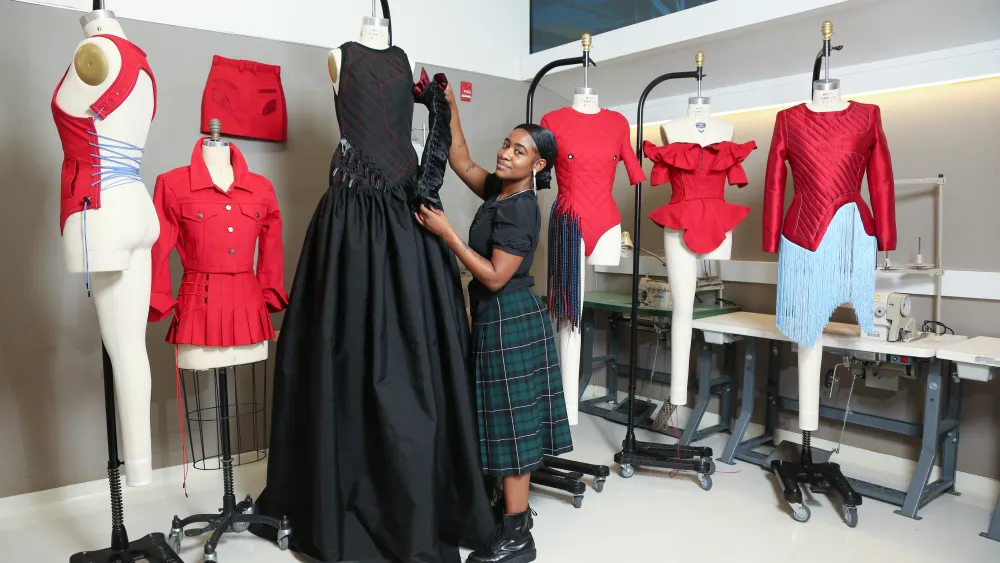Fashion, often regarded as one of the most expressive forms of personal identity, has long been celebrated for its visual allure and intricate design. For decades, it has transcended its role as mere clothing and evolved into a medium through which designers, artists, and wearers convey emotions, culture, and individuality. In recent years, the debate surrounding fashion as an art form has become increasingly prominent. But why is fashion considered an art form, and what makes it stand out in comparison to other creative disciplines? This article explores the reasons why fashion is regarded as an art form, delving into its historical context, creative expression, and the impact it has on society.
Fashion as Art: A Historical Context
Fashion, in its modern sense, dates back centuries, but its status as an art form is a relatively recent phenomenon. Historically, clothing was a utilitarian necessity, a way to protect the body from the elements. However, as civilizations advanced, so did the art of garment-making. In ancient cultures, elaborate costumes and garments began to signify social status, power, and identity, setting the stage for the role fashion would play in art and culture.
In the 20th century, the fashion industry began to emerge as a professional field, and designers such as Coco Chanel, Christian Dior, and Yves Saint Laurent elevated fashion to new heights. These designers revolutionized how people thought about clothing, showcasing not only practical wearables but also works of art that could evoke emotions and symbolize changing societal norms. Fashion was no longer just about dressing the body—it became a form of cultural expression and self-representation.
Today, fashion is recognized as an art form for several reasons. It involves creativity, craftsmanship, and a deep understanding of aesthetic principles, all of which are essential qualities in the world of art.
Fashion Is a Medium for Creative Expression
At its core, fashion is about creativity. Much like painters use canvas and sculptors use clay, fashion designers use fabric, textiles, and threads to create masterpieces that express their ideas, visions, and artistic sensibilities. Designers are often inspired by various artistic disciplines, from fine arts to music to architecture, and these influences can be seen in the garments they produce.
The process of designing fashion requires skill, imagination, and a unique point of view. Designers envision garments that go beyond the simple act of clothing the body—they aim to evoke feelings, make statements, and sometimes challenge societal norms. Just like a painter creates a visual experience on a canvas, a designer creates an immersive, multi-dimensional experience through the use of colors, textures, shapes, and patterns.
Fashion is often showcased in runway shows, where models become the “living canvas” for designers’ creations. These shows are elaborate performances, merging art, music, and design in a way that reflects the fluid and evolving nature of fashion as a form of expression. The clothing becomes part of a larger narrative, blending aesthetics with storytelling.
The Intersection of Fashion and Culture
Fashion has a profound impact on culture. It reflects societal changes, political climates, and cultural movements. Much like other forms of art, fashion serves as a mirror to the world, reflecting both the zeitgeist and the evolving social landscape. For instance, the flapper dresses of the 1920s symbolized a break from tradition and the embracing of modernity, while the punk fashion of the 1970s represented a rebellion against established societal norms.
Designers frequently use their collections to comment on current events, challenge stereotypes, or address cultural issues. Fashion becomes a platform for social commentary, offering powerful messages to audiences through the clothes themselves. From political statements on the runway to the use of fashion in protest movements, the power of fashion as a medium for cultural expression cannot be underestimated.
The diversity of styles, trends, and cultural references present in fashion further emphasizes its role as an art form. Whether it’s African prints influencing Western fashion, the global rise of streetwear, or the incorporation of historical references into modern designs, fashion celebrates cultural diversity and encourages a rich exchange of ideas.
Fashion and the Sense of Identity
One of the most profound aspects of fashion as an art form is its ability to shape and express individual identity. Clothing allows people to showcase their personality, beliefs, and values to the world without saying a word. It is a means of self-expression and empowerment, with each garment telling a story about the wearer’s life, interests, and style.
Just like how a painter chooses certain colors and brushstrokes to represent their emotions, an individual chooses what to wear based on how they want to feel and how they want others to perceive them. Fashion gives individuals the power to express themselves in ways that words or actions alone cannot. For this reason, fashion is often intertwined with the concept of identity—both individual and collective.
The notion of identity extends beyond the personal level and into the cultural and political spheres. Fashion has been used historically as a symbol of resistance, empowerment, and unity. For example, the feminist movement adopted certain fashion pieces as symbols of independence and strength, while the LGBTQ+ community has used fashion as a vehicle for expression and acceptance. In this way, fashion is not only an art form but a tool for social change.
Fashion as an Art Form in the Contemporary World
In the contemporary world, fashion’s artistic influence is more evident than ever. The fashion industry has expanded to encompass everything from haute couture runway shows to street style, and from collaborations between designers and artists to fashion exhibitions in museums. The integration of fashion with other creative industries has led to a more seamless fusion of art, design, and commerce.
Many museums, including the Metropolitan Museum of Art’s Costume Institute, host fashion exhibitions that examine fashion as an art form. These exhibitions showcase the artistry of designers, focusing on the intricacy, design process, and cultural significance of fashion. Similarly, fashion films, documentaries, and art galleries dedicated to fashion photography allow viewers to experience the artistic nature of clothing beyond the confines of the runway or retail store.
Fashion houses like Chanel, Louis Vuitton, and Balenciaga continue to blur the lines between art and design. Their collections are not just about clothing—they are about crafting a narrative, creating a spectacle, and showcasing the creativity of the designers in ways that challenge the traditional concept of fashion as purely functional.
The Role of Technology in Fashion as an Art Form
As technology advances, the realm of fashion continues to evolve. From 3D printing to augmented reality, new technological tools are being used to push the boundaries of design and creativity. Fashion designers are exploring new materials, digital fabrics, and sustainable practices, offering endless possibilities for creative expression.
For example, designers now use AI (artificial intelligence) and machine learning to predict trends, optimize production, and explore new design possibilities. These technological innovations enable designers to push their creative limits, resulting in fashion that is not only artistic but also innovative and futuristic.
Virtual fashion shows and digital fashion have emerged, where garments are created and displayed in virtual worlds, expanding the definition of fashion and art even further. These technological advances allow for limitless creativity in design, demonstrating the way technology can enhance fashion’s role as an art form.
FAQs about Fashion as an Art Form
- What makes fashion an art form? Fashion is considered an art form because it involves creativity, design, and craftsmanship, much like other artistic disciplines. Designers use materials like fabric, color, and texture to create visually appealing and thought-provoking works of art.
- How does fashion reflect culture? Fashion reflects culture by showcasing societal values, trends, and beliefs. It allows designers and wearers to comment on and participate in cultural movements, making it a powerful medium for cultural expression.
- Why is fashion considered a form of self-expression? Fashion is a way for individuals to communicate their personality, emotions, and beliefs through what they wear. Clothing choices can reflect personal identity, and individuals often use fashion as a tool for expressing their inner selves.
- What role does fashion play in social movements? Fashion has historically been used as a tool for social change and activism. For example, it has been used in feminist movements, civil rights protests, and LGBTQ+ advocacy to convey messages of empowerment and equality.
- Is fashion art or commerce? Fashion is both an art and a commercial industry. While the creative aspects of design and expression are at the core of fashion, the fashion industry also serves as a global economic powerhouse, with designers and brands creating products that are sold worldwide.
- How is fashion showcased as art in museums? Fashion is showcased as art in museums through exhibitions that focus on the artistry of fashion design, the cultural significance of clothing, and the history of fashion trends. Museums often display garments as works of art in their own right.
- Can fashion be a form of protest? Yes, fashion can be a form of protest. Throughout history, fashion has been used to challenge social norms and express dissent, such as the use of black clothing during political protests or the wearing of specific garments to symbolize solidarity with a cause.
Conclusion
Fashion is much more than just clothing—it is a living, breathing art form that has the power to communicate, express, and transform. From the creative vision of designers to the ways in which individuals use fashion to define their identity, fashion is a form of artistic expression that reflects culture, challenges conventions, and empowers people.
As technology continues to shape the future of fashion, its status as an art form will only become more pronounced. The fusion of craftsmanship, cultural relevance, and artistic innovation makes fashion one of the most dynamic and influential art forms of our time.
Key Takeaways
- Fashion is considered an art form because it involves creativity, design, and craftsmanship.
- Fashion reflects cultural movements, societal values, and the evolving times.
- It allows individuals to express their identity and communicate their beliefs.
- Fashion can be used as a powerful tool for social change and activism.
- Technology is expanding the boundaries of fashion, pushing its artistic limits.
- Fashion exhibitions and museum collections help to showcase the artistry behind garments.
- Fashion is a form of art that constantly evolves and influences the world in profound ways.




